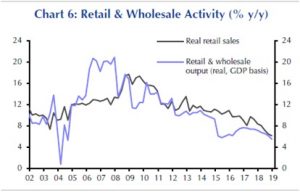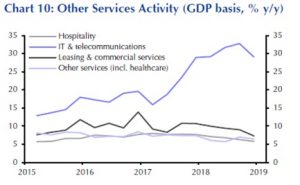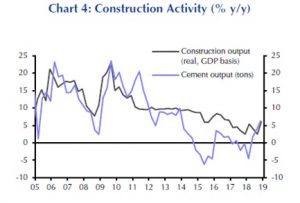Daily Comment (January 22, 2019)
by Bill O’Grady and Thomas Wash
[Posted: 9:30 AM EDT] Welcome back from the long weekend. Equities are in the red this morning mostly on worries about global growth. Here is what we are watching today:
The IMF, global growth and Davos: The IMF has reduced its world growth forecast to 3.5% for this year (down 0.2% from its October estimate) and 3.6% in 2020 (down 0.1% from October).[1] Noted concerns were widespread, including a hard Brexit, worries about Italy’s budget and global trade. The IMF noted that global direct investment fell 19% in 2018.[2] The Davos meetings are underway in Switzerland. The lineup is “lighter” than in previous years; of the G-7, only Germany, Italy and Japan are sending national leaders. The U.S. has no official representation due to the shutdown. PM May and President Macron are not at the forum due to domestic turmoil. Xi Jinping and India’s Modi are also taking a pass. Although climate change is the topic of this year’s meeting, concerns about global growth are the unofficial worry.[3]
China’s GDP: Over the holiday, China announced its weakest GDP growth since 1990[4] as reported growth fell to 6.4% in Q4. In general, GDP growth in China is often overstated; a better approximation is probably closer to 5.3%, which is still rather strong but also weakening. The details of the data are worrying. They confirm that real estate and retail sales slowed. China needs to reform its economic model away from investment and exports toward consumption; slowing retail sales is bad news.

Information technology remains very robust but is slowing.

As growth slows, there is evidence that China is “returning to the one that brought you,” or construction.

Essentially, China can achieve any growth level it wants by accumulating debt. But, the Xi government is trying to deleverage in an attempt to ease bad debt and excessive investment. Unfortunately for China, it can either reduce debt or grow fast, but it can’t do both.
Xi and the CPC: In a recent speech, Chairman Xi warned of the need to maintain stability under conditions of growing stress. Although such speeches are not exactly unusual for Xi, this one seemed to be a bit more strident that normal. For the most part, China abhors chaos; throughout its history, periods of weak governance have led to either foreign invasion or internal breakdowns that led to warlords dividing the country. History also shows that the coastal regions tend to have the strongest economic growth but only during periods when the coasts are exporting to the world. The divergence between the coasts and the interior can be sources of division that undermine governance. Mao unified China by turning the country inward; thus, China was united but poor. Deng was willing to risk that division for growth; now, China has a robust economy but also severe income and regional inequality. Xi is trying to address these issues.[5] The trick is that communism, for the most part, is a spent ideology. Xi often talks in terms of a dialectic, the familiar “thesis-antithesis-synthesis” language that Marx borrowed from Hegel. What makes that construct attractive is that it implies progress—an existing system or power structure faces a threat and the threat is absorbed by taking the best of both. Of course, after that, the new synthesis eventually becomes the next thesis and the process repeats. However, there is another alternative; there is no progress and history merely cycles between two polar positions and progress is often an illusion provided by better technology. Xi is worried. Since no one really buys into Marxism anymore, the legitimacy of the CPC is mostly derived from its ability to deliver growth and improve living standards. However, that growth has led to its own problems—pollution, income inequality, etc. The last two governments have tried to address both with mixed success. But, it has become difficult to address these other issues and maintain strong growth. To do so, the party has relied on debt growth, which is now becoming problematic.
Brexit and Plan B: PM May revealed her “Plan B”; essentially,[6] it is “Plan A” with the hopes that the EU will give her some room on the Irish backstop issue. Her offer was mostly panned by the MPs.[7] However, divergences are starting to show. May has maintained all along that she cannot take hard Brexit off the table, but there is a growing rebellion among Tory MPs to do just that.[8] The official line from the EU is that there is no room to negotiate on “red lines,” which means the U.K. must stay in the customs union in order to avoid a hard border in Ireland. That position was reiterated by the lead EU negotiator, Michel Barnier.[9] However, the Polish foreign minister, Jacek Czaputowicz, suggested that May’s Brexit deal might pass Parliament if the backstop is temporary, for five years, perhaps.[10] On the one hand, it isn’t obvious that Poland is leading negotiations; on the other, the EU requires unanimity and if Poland is willing to allow a temporary backstop then there might be a crack in the EU negotiating strategy. Poland is quite interested in the Brexit negotiations as nearly one million of its citizens reside in the U.K. Poland would likely be willing to give a time limit on the backstop in return for protection for Poles in Britain. To some extent, this crack may be what May was hoping for all along.
At the same time, Labour’s Corbyn appears to be supporting a second referendum, something he has been reluctant to back. His concern is that there is some support for Brexit among the hard left (the Blair Labourites were solid on Remain) and, if a second referendum were to yield a reversal of Brexit, it might not only split the Tories but could also divide Labour.
The EU is also making it clear that it won’t extend the Article 50 deadline without good reason, and a disruptive hard Brexit isn’t a good enough reason. Only elections or a needed extension for additional Parliamentary votes will pass muster. We note that May’s widely panned Brexit strategy is getting a second look by some Brexit supporters, fearing that a rejection of May’s plan may lead to no Brexit at all.[11] Thus, the Polish offer might be enough to swing May’s coalition to her plan. Or, in the words of Monty Python, her plan’s “not dead yet.”[12]
At last, Sweden gets a government: It took 133 days from the last election but the Social Democrats have cobbled together a minority government. In the last election, the Sweden Democrats, a right-leaning, anti-immigrant populist party, won 62 out of 349 seats in the Swedish parliament. The Social Democrats bloc, a mostly center-left coalition, won 144, while the center-right coalition, led by the Moderate Party, won 143. That outcome meant the Sweden Democrats had the power to determine the next government. However, neither of the traditional coalition blocs wanted to form a government with the populist Sweden Democrats, meaning that the new government would either be a minority arrangement or the centrist blocs would need to form a grand coalition (like what happened in Germany to avoid a coalition with the AfD). The center-left formed a minority government but has gotten support from the Liberals and Center Party, who lean libertarian and are usually part of the center-right bloc. To form a government, the Social Democrats had to accept mandatory language testing for naturalized citizens, tax cuts and labor market deregulation. We doubt the government will survive a full four-year term. Both the left and right were critical of the deal but, at least for now, Sweden finally has a government.[13]
As we have seen elsewhere in Europe, centrist parties are trying to deal with the rise of populism. In France, the run-off system prevented the National Rally from winning the presidency. In Germany, it took a grand coalition that essentially emasculates the Social Democrats in order to govern. In Italy, the populists have won but both left- and right-wing populists share power, which may not survive. Although populists are not necessarily the majority, they are getting powerful enough to disrupt what has been the normal power arrangements. This is how populism has operated in proportional representation systems. In “first past the post” systems like the U.K. and U.S., populism is rapidly changing earlier arrangements. In Britain, it has led to Brexit; in the U.S., it has led the GOP to become the party of protectionism and is producing divisions in the Democrats on how to manage and regulate technology companies. Sweden is just the latest country to deal with this trend.
[1] https://www.reuters.com/article/us-davos-meeting-imf/imf-fears-trade-war-and-weak-europe-could-trigger-sharp-global-slowdown-idUSKCN1PF19S
[2] https://www.ft.com/content/d0413d18-1d72-11e9-b126-46fc3ad87c65
[3] https://www.ft.com/content/27926bca-1d99-11e9-b2f7-97e4dbd3580d
[4] https://www.ft.com/content/d0413d18-1d72-11e9-b126-46fc3ad87c65
[5] https://www.yahoo.com/news/china-apos-xi-calls-political-103056500.html
[6] https://www.youtube.com/watch?v=5IsSpAOD6K8 and https://www.washingtonpost.com/world/theresa-mays-brexit-plan-b-leaves-parliament-underwhelmed/2019/01/21/1b7e43bc-1b5b-11e9-b8e6-567190c2fd08_story.html?utm_term=.ba0790bd662a&wpisrc=nl_todayworld&wpmm=1
[7] https://www.ft.com/content/9d93394d-779b-3bf7-9c23-db4d0ce8dd04?emailId=5c46b2c4b8863d0004cb5f85&segmentId=22011ee7-896a-8c4c-22a0-7603348b7f22
[8] https://www.thetimes.co.uk/edition/news/dozens-of-ministers-ready-to-quit-over-brexit-xq6rh80sj
[9] https://www.ft.com/content/ee06a784-1d77-11e9-b126-46fc3ad87c65?emailId=5c46b2c4b8863d0004cb5f85&segmentId=22011ee7-896a-8c4c-22a0-7603348b7f22
[10] https://www.politico.eu/article/brussels-scrambles-to-deal-with-polands-brexit-curve-ball/?utm_source=POLITICO.EU&utm_campaign=5045bde362-EMAIL_CAMPAIGN_2019_01_22_04_47&utm_medium=email&utm_term=0_10959edeb5-5045bde362-190334489
[11] https://www.ft.com/content/2e488214-1d9f-11e9-b126-46fc3ad87c65?emailId=5c46b2c4b8863d0004cb5f85&segmentId=22011ee7-896a-8c4c-22a0-7603348b7f22 and https://www.ft.com/content/04ac790a-1a4e-11e9-b93e-f4351a53f1c3
[12] https://www.youtube.com/watch?v=dGFXGwHsD_A
[13] https://www.nytimes.com/2019/01/18/world/europe/sweden-government.html


